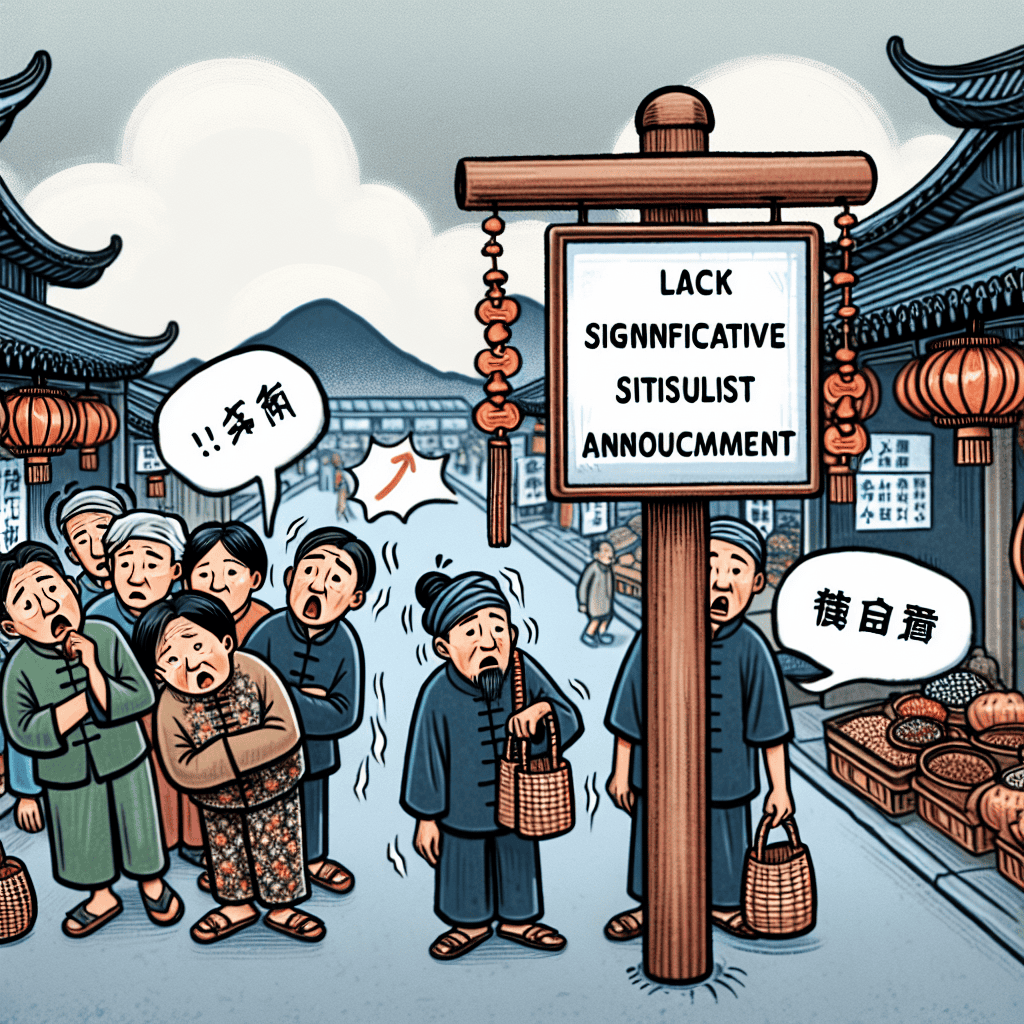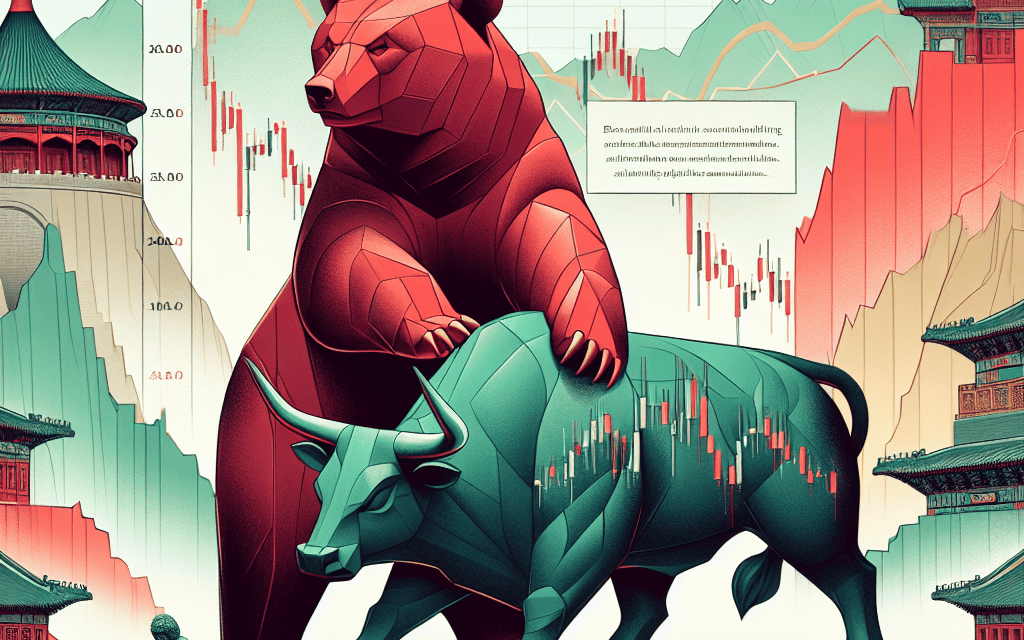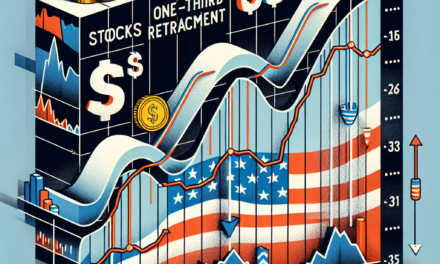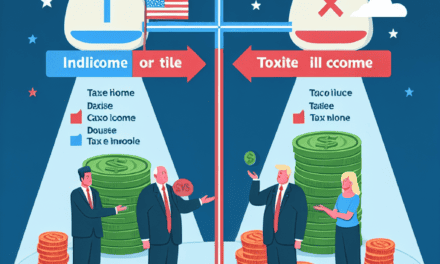“Chinese Stock Rally Stalls: Markets Await Stimulus Spark”
Introduction
In recent months, the Chinese stock market has experienced a notable rally, driven by investor optimism and expectations of economic recovery. However, this upward momentum has begun to falter as the anticipated significant stimulus measures from the Chinese government have not materialized. Market participants had been hopeful for robust policy interventions to bolster economic growth and support key sectors, but the absence of substantial announcements has led to increased uncertainty and volatility. This hesitation in policy action has raised concerns about the sustainability of the rally, prompting investors to reassess their positions and weigh the potential risks and rewards in the current economic landscape. As a result, the Chinese stock market faces a critical juncture, with its future trajectory hinging on the government’s next moves and the broader global economic environment.
Impact Of Limited Stimulus On Chinese Stock Market
The recent rally in Chinese stocks has encountered a significant roadblock, as the anticipated government stimulus measures have not materialized to the extent that investors had hoped. This development has led to a reassessment of market expectations and a subsequent cooling of enthusiasm among investors. Initially, the prospect of substantial economic stimulus had fueled optimism, driving a surge in stock prices. However, the absence of concrete and impactful policy announcements has tempered this optimism, leading to a more cautious market sentiment.
In recent months, the Chinese government has been under pressure to bolster its economy amid slowing growth and external challenges. Investors had been eagerly awaiting a series of robust stimulus measures that would inject vitality into the market and support economic expansion. However, the measures announced thus far have been perceived as insufficient in scale and scope to address the underlying economic issues. This perception has been a key factor in the faltering of the stock rally, as market participants recalibrate their expectations in light of the limited policy interventions.
The impact of this limited stimulus is multifaceted. On one hand, it has led to a decline in investor confidence, as market participants question the government’s commitment to supporting economic growth. This skepticism is reflected in the volatility of stock prices, as investors react to the lack of decisive action. On the other hand, the restrained approach to stimulus may be indicative of the government’s cautious stance, aiming to avoid exacerbating existing financial imbalances and long-term structural issues. This balancing act between short-term economic support and long-term stability presents a complex challenge for policymakers.
Moreover, the global economic environment adds another layer of complexity to the situation. With ongoing trade tensions and geopolitical uncertainties, the Chinese economy faces external pressures that further complicate the domestic policy landscape. The limited stimulus measures may be a strategic response to these external factors, as the government seeks to maintain a degree of flexibility in its policy toolkit. However, this approach has not been sufficient to assuage investor concerns, leading to a subdued market response.
In addition to these factors, the performance of specific sectors within the Chinese stock market has been uneven, reflecting the broader economic challenges. Industries that are heavily reliant on government support, such as infrastructure and real estate, have been particularly sensitive to the lack of substantial stimulus. Conversely, sectors that are less dependent on government intervention, such as technology and consumer goods, have shown relative resilience. This divergence underscores the varied impact of limited stimulus across different segments of the economy.
In conclusion, the faltering of the Chinese stock rally amid a lack of significant stimulus announcements highlights the intricate interplay between government policy, investor expectations, and broader economic conditions. While the restrained approach to stimulus may be a calculated move by the government, it has nonetheless led to a recalibration of market sentiment. As investors navigate this uncertain landscape, the focus will likely remain on the government’s next steps and their potential implications for the stock market and the broader economy. The challenge for policymakers will be to strike a balance between providing immediate economic support and ensuring long-term financial stability, a task that will require careful consideration and strategic foresight.
Investor Sentiment In The Wake Of Chinese Stock Rally Faltering
Investor sentiment has been notably impacted by the recent faltering of the Chinese stock rally, which had initially sparked optimism among global investors. The rally, which began earlier this year, was fueled by expectations of substantial economic stimulus from the Chinese government. However, as the anticipated announcements failed to materialize, the momentum behind the rally has waned, leaving investors to reassess their positions and strategies.
Initially, the rally was driven by a combination of factors, including a rebound in consumer spending and a recovery in key sectors such as technology and manufacturing. These developments were seen as signs of resilience in the Chinese economy, which had been grappling with the lingering effects of the COVID-19 pandemic. Moreover, the Chinese government’s previous track record of implementing large-scale stimulus measures during economic downturns had led many to believe that similar actions would be forthcoming. This belief was further bolstered by official statements hinting at potential policy support to sustain economic growth.
However, as weeks turned into months without any significant stimulus announcements, investor confidence began to waver. The absence of concrete measures has raised concerns about the sustainability of the economic recovery, particularly in light of ongoing challenges such as rising debt levels and geopolitical tensions. Furthermore, the Chinese government’s focus on long-term structural reforms, rather than short-term stimulus, has added to the uncertainty. While these reforms are aimed at ensuring sustainable growth, they do not provide the immediate boost that many investors had been hoping for.
In addition to the lack of stimulus, other factors have contributed to the cooling of the stock rally. Regulatory crackdowns on various sectors, including technology and real estate, have created an environment of caution among investors. These crackdowns, aimed at addressing issues such as monopolistic practices and financial risks, have led to increased volatility in the markets. As a result, investors are now more circumspect, weighing the potential risks and rewards of their investments in Chinese equities.
Moreover, the global economic landscape has also played a role in shaping investor sentiment. With central banks in major economies signaling tighter monetary policies to combat inflation, there is a growing concern about the impact of rising interest rates on global liquidity and capital flows. This has led to a reevaluation of risk assets, including Chinese stocks, as investors seek to navigate an increasingly complex and interconnected financial environment.
Despite these challenges, it is important to note that the Chinese economy remains a key driver of global growth. The country’s ongoing efforts to transition to a more sustainable and innovation-driven economic model hold significant long-term potential. However, in the short term, the lack of immediate stimulus measures has created a more cautious atmosphere among investors, who are now looking for clearer signals from policymakers.
In conclusion, the faltering of the Chinese stock rally amid the absence of significant stimulus announcements has led to a shift in investor sentiment. While the initial optimism has been tempered by uncertainty and regulatory challenges, the long-term prospects of the Chinese economy continue to offer opportunities for discerning investors. As the situation evolves, market participants will be closely monitoring developments, seeking to balance the risks and rewards in a dynamic and ever-changing landscape.
Comparative Analysis: Chinese Stock Market Vs. Global Markets
The recent performance of the Chinese stock market has been a subject of considerable interest and scrutiny, particularly in comparison to global markets. Initially, there was a surge of optimism among investors, driven by expectations of substantial economic stimulus from the Chinese government. However, this rally has recently faltered, primarily due to the absence of significant policy announcements that could bolster economic growth. This development invites a comparative analysis of the Chinese stock market’s trajectory against the backdrop of global market trends.
To begin with, the initial rally in Chinese stocks was largely fueled by speculation that the government would introduce robust fiscal and monetary measures to counteract the economic slowdown. Investors anticipated that such interventions would stimulate domestic consumption and investment, thereby enhancing corporate earnings and stock valuations. However, as these expectations have not materialized in the form of concrete policy actions, investor sentiment has waned, leading to a stagnation in stock prices. This lack of decisive stimulus has left market participants questioning the government’s commitment to revitalizing the economy, thereby dampening the initial enthusiasm.
In contrast, global markets have exhibited a more varied performance, influenced by a multitude of factors including geopolitical tensions, inflationary pressures, and central bank policies. For instance, in the United States, the Federal Reserve’s monetary tightening measures have been a significant driver of market volatility. While these actions aim to curb inflation, they have also raised concerns about potential economic slowdowns, thereby impacting investor confidence. Similarly, European markets have been navigating the complexities of energy supply disruptions and their implications for economic stability. Despite these challenges, some global markets have managed to maintain a degree of resilience, supported by strong corporate earnings and sector-specific growth.
The divergence between the Chinese stock market and its global counterparts can be attributed to several underlying factors. One key difference lies in the policy approaches adopted by respective governments. While many developed economies have implemented aggressive stimulus measures in response to economic challenges, China’s approach has been more measured and cautious. This restraint is partly due to the government’s focus on long-term structural reforms and financial stability, rather than short-term economic boosts. Consequently, the absence of immediate stimulus in China has created a stark contrast with the proactive measures seen in other major economies.
Moreover, the Chinese stock market is also influenced by unique domestic factors, such as regulatory changes and sector-specific policies. For example, the government’s regulatory crackdown on technology and education sectors has had a pronounced impact on market dynamics, contributing to investor uncertainty. In comparison, global markets are more heavily swayed by macroeconomic indicators and international developments, which can lead to different investment patterns and outcomes.
In conclusion, the faltering rally in the Chinese stock market, amid a lack of significant stimulus announcements, highlights the complexities of navigating economic policy and market expectations. While global markets face their own set of challenges, the contrast in policy responses underscores the diverse strategies employed by governments to address economic uncertainties. As investors continue to assess these developments, the interplay between domestic policies and global market trends will remain a critical factor in shaping future market trajectories. This comparative analysis underscores the importance of understanding both local and international contexts in making informed investment decisions.
Economic Indicators Influencing Chinese Stock Performance

The recent performance of Chinese stocks has been a subject of considerable interest among investors and analysts alike, particularly in light of the anticipated economic stimulus measures from the Chinese government. Initially, there was a wave of optimism that propelled a rally in the stock market, driven by expectations that the government would introduce significant fiscal and monetary policies to bolster economic growth. However, this rally has recently faltered, largely due to the absence of substantial stimulus announcements, which has left investors reassessing their positions and the broader economic outlook.
To understand the dynamics at play, it is essential to consider the economic indicators that have been influencing Chinese stock performance. One of the primary factors is the country’s GDP growth rate, which has shown signs of slowing down. This deceleration has raised concerns about the sustainability of China’s economic expansion, prompting calls for government intervention to stimulate growth. In response, the Chinese government has hinted at potential measures, such as tax cuts and increased infrastructure spending, but concrete actions have yet to materialize. This lack of decisive policy implementation has contributed to the waning confidence among investors.
Moreover, the performance of the manufacturing sector, a critical component of China’s economy, has also been under scrutiny. Recent data indicate a contraction in manufacturing activity, which has further exacerbated fears of an economic slowdown. The Purchasing Managers’ Index (PMI), a key indicator of manufacturing health, has dipped below the threshold that separates expansion from contraction. This decline has underscored the need for targeted stimulus to revitalize the sector and, by extension, the broader economy. However, the absence of significant policy announcements has left market participants uncertain about the future trajectory of the manufacturing industry.
In addition to domestic factors, external economic conditions have also played a role in shaping Chinese stock performance. The global economic environment, characterized by geopolitical tensions and trade uncertainties, has added another layer of complexity. The ongoing trade disputes with major economies have disrupted supply chains and dampened export growth, further straining China’s economic prospects. Investors had hoped that the government would unveil measures to mitigate these external pressures, but the lack of substantial announcements has led to a reassessment of risk and a subsequent cooling of the stock rally.
Furthermore, the real estate sector, which has been a significant driver of China’s economic growth, is facing its own set of challenges. Regulatory measures aimed at curbing speculative activity have led to a slowdown in property sales and construction activity. This has had a ripple effect on related industries, contributing to the overall economic slowdown. While there have been discussions about easing some of these restrictions to stimulate the sector, concrete policy changes have not been forthcoming, adding to the uncertainty in the market.
In conclusion, the faltering of the Chinese stock rally can be attributed to a combination of domestic and external economic indicators, all of which point to a need for decisive government action. The lack of significant stimulus announcements has left investors in a state of uncertainty, prompting a reevaluation of their investment strategies. As the Chinese government continues to navigate these complex economic challenges, the market will be closely watching for any signs of policy shifts that could reignite investor confidence and drive a renewed rally in Chinese stocks.
Government Policies And Their Effect On Chinese Stock Market
The Chinese stock market, a barometer of the country’s economic health, has recently experienced a faltering rally, primarily due to the absence of substantial stimulus measures from the government. Investors, who had been optimistic about potential policy interventions to bolster economic growth, are now reassessing their positions as the anticipated support has not materialized. This development underscores the intricate relationship between government policies and market performance, highlighting the critical role of state intervention in shaping investor sentiment and market dynamics.
In recent months, the Chinese economy has faced several challenges, including a sluggish property market, rising debt levels, and geopolitical tensions. These factors have collectively dampened economic growth prospects, prompting market participants to look towards the government for decisive action. Historically, the Chinese government has been known to implement robust fiscal and monetary policies to stimulate the economy during downturns. However, the current situation appears to be different, as policymakers have shown restraint in deploying large-scale stimulus measures.
The lack of significant stimulus announcements has led to a sense of uncertainty among investors, who had been banking on government intervention to drive market recovery. This uncertainty is reflected in the performance of Chinese stocks, which have struggled to maintain upward momentum. The initial rally, fueled by expectations of policy support, has lost steam as investors come to terms with the reality of limited government action. Consequently, market volatility has increased, with stock prices experiencing fluctuations in response to any hints of policy changes.
One reason for the government’s cautious approach could be its focus on long-term economic stability rather than short-term market gains. Chinese policymakers are likely wary of exacerbating existing issues, such as high debt levels and asset bubbles, by injecting excessive liquidity into the economy. Instead, they may be prioritizing structural reforms aimed at fostering sustainable growth. This strategy, while prudent from a macroeconomic perspective, may not provide the immediate boost that investors are seeking.
Moreover, the global economic environment adds another layer of complexity to the situation. With major economies grappling with inflationary pressures and tightening monetary policies, China faces external headwinds that could impact its economic trajectory. In this context, the government may be exercising caution to avoid potential spillover effects from global market volatility. This cautious stance, however, may not align with investor expectations, leading to a disconnect between market performance and economic fundamentals.
Despite the current challenges, it is important to recognize that the Chinese government retains significant policy tools at its disposal. Should economic conditions deteriorate further, there remains the possibility of targeted interventions to stabilize the market. For now, however, investors must navigate an environment characterized by uncertainty and limited policy clarity.
In conclusion, the recent faltering of the Chinese stock rally underscores the complex interplay between government policies and market dynamics. While the absence of significant stimulus measures has dampened investor sentiment, it also reflects a strategic focus on long-term economic stability. As the situation evolves, market participants will continue to closely monitor policy signals for any indications of a shift in the government’s approach. Ultimately, the trajectory of the Chinese stock market will depend on a delicate balance between immediate market needs and broader economic objectives.
Future Projections For Chinese Stocks Without Major Stimulus
The recent rally in Chinese stocks, which had initially sparked optimism among investors, has begun to falter as the anticipated major stimulus measures from the Chinese government have yet to materialize. This development has left market participants reassessing their future projections for Chinese equities, as the absence of significant economic support raises questions about the sustainability of the recent gains. As investors navigate this uncertain landscape, it is crucial to understand the factors influencing the market and the potential implications for future performance.
Initially, the rally in Chinese stocks was driven by expectations that the government would introduce substantial stimulus measures to bolster the economy. These expectations were fueled by a series of policy signals and statements from Chinese officials, suggesting that the government was prepared to take decisive action to support growth. However, as time has passed without any major announcements, investor sentiment has begun to wane. The lack of concrete measures has led to increased volatility in the market, as traders grapple with the uncertainty surrounding the government’s economic strategy.
In the absence of significant stimulus, the focus has shifted to the underlying fundamentals of the Chinese economy. While there are areas of strength, such as the continued growth of the technology sector and the resilience of consumer spending, there are also notable challenges. The property market, a critical component of China’s economic engine, remains under pressure due to regulatory tightening and concerns about debt levels. Additionally, the ongoing global economic slowdown and geopolitical tensions have added layers of complexity to the economic outlook.
Given these dynamics, future projections for Chinese stocks are likely to be influenced by a combination of domestic and international factors. Domestically, the trajectory of economic growth will be a key determinant of market performance. Should the government opt for targeted measures, such as tax cuts or infrastructure spending, these could provide a boost to specific sectors and support overall market sentiment. However, without broad-based stimulus, the pace of economic recovery may remain uneven, leading to a more cautious outlook for equities.
On the international front, China’s trade relationships and its role in the global supply chain will also play a significant role in shaping market expectations. As the world continues to grapple with supply chain disruptions and shifting trade dynamics, China’s ability to navigate these challenges will be critical. A stable external environment could provide a tailwind for Chinese stocks, while heightened tensions or disruptions could exacerbate market volatility.
In conclusion, the future projections for Chinese stocks without major stimulus announcements are marked by a degree of uncertainty. While there are pockets of strength within the economy, the lack of significant government intervention has tempered investor enthusiasm. As market participants adjust their expectations, they will need to closely monitor both domestic policy developments and international economic trends. Ultimately, the path forward for Chinese equities will depend on a delicate balance of internal economic resilience and external stability, with investors remaining vigilant in their assessment of the evolving landscape.
Lessons From The Chinese Stock Market’s Recent Performance
The recent performance of the Chinese stock market has been a subject of considerable interest and analysis, particularly as the anticipated rally has faltered due to the absence of significant stimulus announcements. This development offers several lessons for investors and policymakers alike, highlighting the intricate interplay between market expectations and government interventions. Initially, the Chinese stock market experienced a surge in optimism, driven by the anticipation of robust economic stimulus measures from the government. Investors were hopeful that these measures would invigorate economic growth, especially in the wake of challenges such as the lingering effects of the COVID-19 pandemic and ongoing geopolitical tensions. However, as the anticipated announcements failed to materialize, the market’s momentum waned, leading to a reassessment of investment strategies and economic forecasts.
One of the primary lessons from this scenario is the critical role of government policy in shaping market dynamics. In China, where the state plays a significant role in the economy, investor sentiment is often closely tied to government actions and signals. The initial rally was fueled by expectations that the government would implement substantial fiscal and monetary policies to stimulate growth. However, the lack of concrete measures led to a recalibration of expectations, underscoring the importance of clear and decisive policy communication in maintaining market confidence.
Moreover, this situation highlights the inherent volatility and unpredictability of stock markets, particularly in emerging economies. Investors must navigate a complex landscape where political, economic, and social factors can rapidly alter market conditions. The Chinese stock market’s recent performance serves as a reminder of the need for diversified investment strategies that can withstand such fluctuations. By spreading risk across various asset classes and geographies, investors can better manage the uncertainties inherent in markets that are heavily influenced by government policy.
Additionally, the faltering rally underscores the importance of realistic expectations and prudent risk management. While the prospect of government stimulus can create short-term market enthusiasm, it is crucial for investors to maintain a long-term perspective and avoid overreliance on speculative gains. This approach involves a careful assessment of underlying economic fundamentals, such as corporate earnings, consumer demand, and global trade dynamics, which ultimately drive sustainable market growth.
Furthermore, the recent developments in the Chinese stock market offer insights into the broader global economic landscape. As one of the world’s largest economies, China’s economic policies and market performance have far-reaching implications for global trade and investment. The absence of significant stimulus measures not only affects domestic markets but also influences investor sentiment and economic forecasts worldwide. This interconnectedness highlights the need for international cooperation and dialogue to address shared economic challenges and promote stability in global markets.
In conclusion, the faltering rally in the Chinese stock market amid a lack of significant stimulus announcements provides valuable lessons for investors and policymakers. It emphasizes the critical role of government policy in shaping market dynamics, the importance of diversified investment strategies, and the need for realistic expectations and prudent risk management. Additionally, it underscores the interconnectedness of global markets and the importance of international cooperation in addressing economic challenges. As investors and policymakers navigate this complex landscape, these lessons will be essential in fostering sustainable economic growth and stability.
Q&A
1. **Question:** What was the initial cause of the Chinese stock rally?
– **Answer:** The initial cause of the Chinese stock rally was investor optimism about potential government stimulus measures to boost the economy.
2. **Question:** Why did the Chinese stock rally falter?
– **Answer:** The rally faltered due to the lack of significant stimulus announcements from the Chinese government, leading to investor disappointment.
3. **Question:** Which sectors were most affected by the faltering rally?
– **Answer:** Sectors such as technology, real estate, and consumer goods were most affected by the faltering rally.
4. **Question:** How did international investors react to the lack of stimulus?
– **Answer:** International investors became cautious and some withdrew their investments, leading to a decline in stock prices.
5. **Question:** What impact did the faltering rally have on the Chinese economy?
– **Answer:** The faltering rally contributed to increased market volatility and uncertainty about the economic recovery in China.
6. **Question:** Were there any government responses following the faltering rally?
– **Answer:** The government reiterated its commitment to supporting the economy but did not announce any new significant stimulus measures immediately.
7. **Question:** What are analysts predicting for the future of Chinese stocks?
– **Answer:** Analysts are predicting that Chinese stocks may remain volatile in the short term, with potential for recovery if substantial stimulus measures are eventually introduced.
Conclusion
The recent rally in Chinese stocks has lost momentum due to the absence of substantial stimulus measures from the government. Investors had anticipated more aggressive policy interventions to bolster economic growth, but the lack of significant announcements has led to diminished market enthusiasm. This faltering rally reflects broader concerns about China’s economic recovery and the effectiveness of current policy measures in addressing underlying structural challenges. As a result, market participants remain cautious, awaiting clearer signals from policymakers to reinvigorate confidence and drive sustained growth in the stock market.





